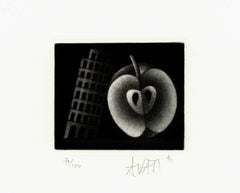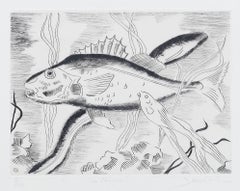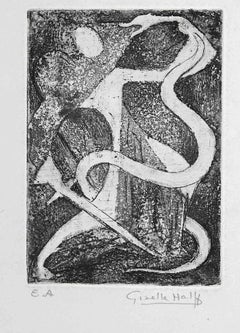Apple Animal Prints
to
1
Overall Width
to
Overall Height
to
1
1
1
1
1
281
2,726
1,782
1,465
1,086
868
544
497
454
447
407
358
350
334
249
238
191
174
151
144
1
1
Art Subject: Apple
Pisa Tower and Apple - Original handsigned black-manner etching - 100 copies
By Mario Avati
Located in Paris, IDF
Mario AVATI
Pisa Tower and Apple
Original black manner etching
Handsigned in pencil
Numbered / 100 copies
On BFK Rives vellum 30 x 19.5 cm (c. 12 x 8 in)
...
Category
1970s Modern Animal Prints
Materials
Etching
Related Items
Fish - Original Etching by Maurice Bouval - 1960s
Located in Roma, IT
Fish is original etching on paper, realized by the French artist Maurice Bouval (1863–1916).
Hand-signed on the lower right and numbered on the lower l...
Category
1960s Modern Figurative Prints
Materials
Etching
$358
H 10.04 in W 13.19 in D 0.04 in
Knight fighting with Serpent - Original Etching by Giselle Halff - 1950s
Located in Roma, IT
Knight fighting with serpent is an original etching on ivory-colored paper realized by Giselle Halff in the mid-20th century.
Hand-signed at the bottom in pencil, and written "E.A" ...
Category
Mid-20th Century Modern Animal Prints
Materials
Etching
$358
H 13 in W 9.85 in D 0.04 in
Swan - Original Etching on Paper - 19th Century
Located in Roma, IT
Swan is an original etching on paper realized by an unknown artist of the XIX century.
The State of preservation is very good.
Sheet dimension: 29 x 22.5 cm.
The artwork represen...
Category
Early 19th Century Modern Figurative Prints
Materials
Paper, Etching
Devastation and Reconstruction - Etching by Marino Marini - 1963
Located in Roma, IT
Devastation and reconstruction is an original etching on paper, realized by Marino Marini in 1963.
Mixed colored etching.
Original title: Devastazione e ricostruzione.
The plate ...
Category
1960s Modern Animal Prints
Materials
Etching
$717
H 19.89 in W 14.97 in D 0.04 in
Bird - Original Etching - 1968
Located in Roma, IT
Bird is an original etching realized in 1968 by an Anonymous artist of the XX century, the state of preservation of the artwork is good.
Hand-signed on the lower right, unreadable, ...
Category
1960s Modern Animal Prints
Materials
Etching
Man on Horseback - Etching - 18th Century
Located in Roma, IT
"Man on Horseback" is an original print in etching technique on ivory-colored cardboard , by Anonymous Artist of the XVIII Century.
In excellent condi...
Category
18th Century Modern Figurative Prints
Materials
Etching
Cowdray Castle (with Geese)
Located in Roma, IT
Beautiful proof on vergé crème, signed by the artist in pencil.
Full margins. Ex-coll. H.H. Benedict (Lugt 1298).
Ref. Cat. Harrington 221; Schneiderman 208.
Category
1880s Modern Landscape Prints
Materials
Drypoint, Etching
The Bird - Original Etching - 1945
Located in Roma, IT
The Bird is an original Etching, realized by an anonymous artist in 1945.
The status of preservation Good.
The artwork is depicted skillfully through confident and strong lines wit...
Category
1940s Modern Figurative Prints
Materials
Etching
Horseman - Original Etching - 1875
Located in Roma, IT
Horseman is an original etching artwork on paper realized in 1875 by Alphonse Edouard Enguérand Aufray de Roc'Bhian (French, Paris 1833– 1887).
Signed on the plate on the lower of t...
Category
1870s Modern Landscape Prints
Materials
Etching
$298
H 9.85 in W 12.8 in D 0.04 in
Cockatiel - Etching by Johann Friedrich Naumann - 1840
Located in Roma, IT
Cockateil is an Etching hand colored realized by Gotthilf Heinrich von Schubert - Johann Friedrich Naumann, Illustration from Natural history of birds in pictures, published by Stutt...
Category
1840s Modern Figurative Prints
Materials
Etching
$358
H 12.01 in W 8.08 in D 0.04 in
The Flower Vase - Etching by Richard Bellies - 1950s
Located in Roma, IT
The Flower Vase is an original etching print on paper realized by Richard Bellies in 1950s.
Hand-signed and dated on the lower right.
Numbered, edition of 24/60 prints.
Included a...
Category
1950s Modern Figurative Prints
Materials
Etching
$334
H 11.82 in W 9.45 in D 0.04 in
Pigeon With Fan Tail - Etching by Johann Friedrich Naumann - 1840
Located in Roma, IT
Pigeon With Fan Tail is an Etching hand colored realized by Gotthilf Heinrich von Schubert - Johann Friedrich Naumann, Illustration from Natural history of birds in pictures, publish...
Category
1840s Modern Figurative Prints
Materials
Etching
$287
H 12.01 in W 8.08 in D 0.04 in


